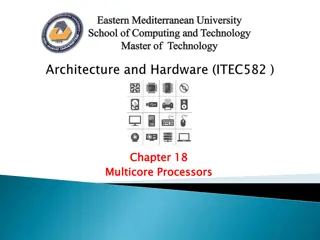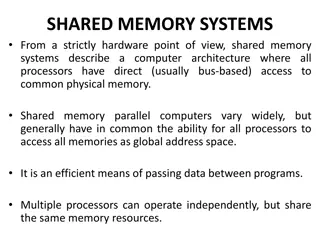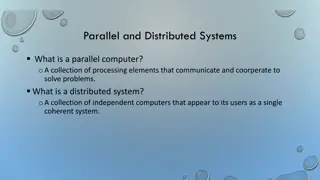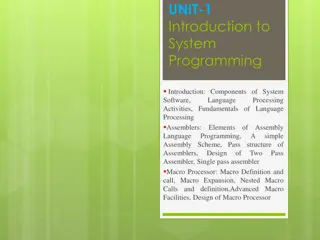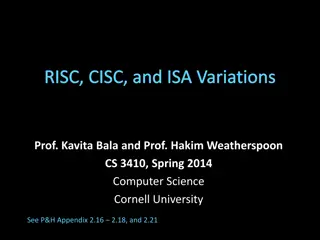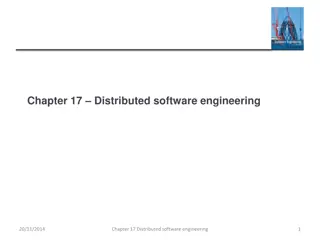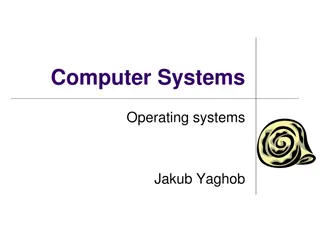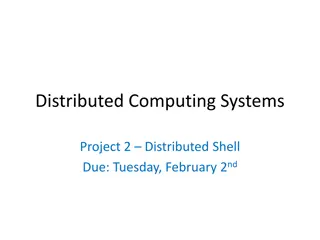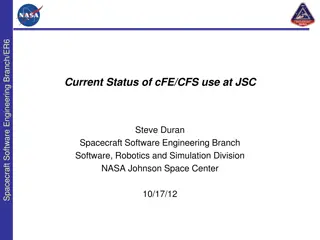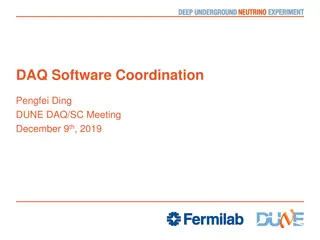Distributed System Architectures: Software for Multiple Processors
Distributed system architectures involve designing software to run on multiple processors, optimizing resource sharing, openness, concurrency, scalability, fault tolerance, and transparency. These systems are crucial in today's world where most computer-based systems are distributed. Various types of systems exist, from personal to embedded to distributed systems, each with unique characteristics and challenges. Understanding client-server and object architectures, as well as the role of middleware in managing different components, is key in software engineering for distributed systems.
Download Presentation

Please find below an Image/Link to download the presentation.
The content on the website is provided AS IS for your information and personal use only. It may not be sold, licensed, or shared on other websites without obtaining consent from the author.If you encounter any issues during the download, it is possible that the publisher has removed the file from their server.
You are allowed to download the files provided on this website for personal or commercial use, subject to the condition that they are used lawfully. All files are the property of their respective owners.
The content on the website is provided AS IS for your information and personal use only. It may not be sold, licensed, or shared on other websites without obtaining consent from the author.
E N D
Presentation Transcript
Medicare Advantage 101 July 2022
Overview In 2012, LeadingAge produced its first managed care toolkit. By 2022, the managed care landscape has been dramatically altered impacting many more older adults and the providers who serve them: Medicare Advantage enrollment has grown to 45%1 Medicaid Managed LTSS is in 24 states2, 5 Medicare-Medicaid Programs through the Financial Alignment Initiative are in 13 states3 Over 11 million Medicare beneficiaries were enrolled in Accountable Care Organizations in 20224 1https://www.chartis.com/insights/medicare-advantage-enrollment-continues-surge-increasingly-complex-and-competitive 2 http://www.advancingstates.org/sites/nasuad/files/2021%20-%20Demonstrating%20the%20Value%20of%20MLTSS.pdf 3 https://innovation.cms.gov/innovation-models/financial-alignment 4 https://www.cms.gov/files/document/2022-shared-savings-program-fast-facts.pdf 5 https://www.kff.org/medicaid/issue-brief/10-things-to-know-about-medicaid-managed-care/
The Managed Care Environment Medicare Advantage/ Special Needs Plans Medicaid Managed Care/ MLTSS Alternative Payment Models (CMMI) By 2030, all Medicare beneficiaries will be in an accountable care relationship with accountability for quality and total cost of care. -- Center for Medicare and Medicaid/ Center for Medicare and Medicaid Innovation
Changing Payment and Delivery Environment Medicare Advantage is one piece of a broader federal policy direction to improve health care outcomes, lower costs and to provide greater spending predictability to government payers. These policy shifts are having the following impacts on the delivery of health care services to older adults: New payment models place increasing proportions of providers revenue at-risk based upon provider performance and care outcomes Value based payment programs (e.g., up to 2% of SNFs Medicare rates) Risk-based models being tested: Bundled Payment, Accountable Care Organizations, and Medical Homes Medicare Advantage and Special Needs Plans Changing Care Delivery Patterns: Managed care models succeed by altering the amount and type of care and services provided Avoidance of unnecessary hospitalizations through early identification and intervention (e.g. preventative care) Fewer SNF stays and home health visits Shorter lengths of stay within SNFs Prior authorizations and other utilization management tools are used by plans to lower costs Plans use third party organizations to deploy post-acute care delivery changes including substitutions of care to lower cost settings MA plans increasingly are seeking to narrow, preferred provider networks, often excluding smaller/single site providers Plans are achieving savings by changing care delivery patterns and paying providers less than Original Medicare 4
Changing Payment and Delivery Environment Pain with Little or No Gain: PAC and LTSS providers efforts help to generate savings but those providers are given contracts at less than current Medicare FFS rates, and are rarely offered value-based arrangements or a share of the savings achieved under alternative payment models and managed care plans Patient's Choice (e.g., provider, plan, etc.) determines payer and model, PAC/LTSS providers have little control over terms: Medicare beneficiaries choose whether to remain in original Medicare or enroll in a MA plan to receive their Medicare Part A & B benefits. Beneficiaries who remain in original Medicare may be attributed to a Medicare Accountable Care Organization, or Bundled Payment program (e.g., Bundled Payment for Care Improvement or Comprehensive Care for Joint Replacement (without their knowledge)) based upon the provider from which they receive most of their care. Regardless, the provider is subject to the payment structure and processes of the model the beneficiary is enrolled in. Enrollment in Medicare Advantage and Medicaid Managed Care LTSS on the rise Payers seeking greater predictability on costs Providers now subject to multiple payers with multiple ways of doing things
6 2022 Medicare Advantage Penetration & Growth Source: Medicare Advantage Enrollment Continues to Surge in an Increasingly Complex and Competitive Landscape, 2022 Medicare Advantage Competitive Enrollment Report, THE CHARTIS GROUP, March 29, 2021. State/County MA enrollment data: https://www.cms.gov/ Research-Statistics- Data-and- Systems/Statistics- Trends-and- Reports/MCRAdvPart DEnrolData/Monthly- MA-Enrollment-by- State-County- Contract
MA Trends Overview Beneficiary Choice: In 2022, Medicare eligible beneficiaries chose MA over Traditional Medicare approximately 2 to 1 MA to Be Majority Payer: MedPAC projects that more than 50% of Medicare beneficiaries will be enrolled in MA by 20232 Satisfaction: 88% of MA Enrollees are satisfied with their MA plan Of those who are dissatisfied, 29% cite lack of coverage of their preferred providers. Cost is a Decision Point: 2/3rds of those who chose MA over Medigap did so because of cost Source:1) The Medicare Advantage Opportunity: How payers and providers can capitalize on this growing segment, Cerner; 2) https://www.medpac.gov/wp- content/uploads/2022/03/Mar22_MedPAC_ReportToCongress_Ch12_SEC.pdf 3 & 4) https://news.ehealthinsurance.com/_ir/68/20225/Spotlight_On_Medicare_Advantage_eHealth_Su rvey_June2022.pdf
MA Enrollee Demographics 53% have incomes < 200%FPL* (38% in FFS) 34% are from diverse populations (16% FFS) 57% are female (same as FFS) MA enrollees have poorer reported health -69% Fair or Poor (55% FFS) 40% of enrollees are 75 years+ (35% in FFS) 82% live in Urban Area (66% in FFS) * In 2022, 200% FPL is $27, 180 for an individual and $36,620 for a couple Sources: https://bettermedicarealliance.org/wp-content/uploads/2022/07/BMA-State-of-MA-2022-FIN.pdf; https://bettermedicarealliance.org/wp-content/uploads/2020/12/BMA-High-Need- Report.pdf; https://aspe.hhs.gov/sites/default/files/documents/f81aafbba0b331c71c6e8bc66512e25d/medic are-beneficiary-enrollment-ib.pdf; https://www.medpac.gov/wp- content/uploads/2022/07/July22_MedPAC_DataBook_SEC.pdf
2022 Enrollment Trends 85% of all MA enrollment is in for-profit plans UnitedHealth; Centene and Aetna lead enrollment Special Needs Plan enrollment grew 20% in 2021 to 4.5 million (almost double from 2017) 1 in 6 beneficiaries are enrolled in a SNP MA enrollment exceeds 50% of eligible Medicare Beneficiaries in: 11 states (only 3 states in 2021) : AL, CT, FL, HI, ME, MI, MN, OH, OR, RI, WI 123 of 435 Congressional Districts In 22 states, 40% or more of Medicare beneficiaries are enrolled in Medicare Advantage or Special Needs Plans Only 6 states and the District of Columbia have fewer than 20% of Medicare beneficiaries Source: https://bettermedicarealliance.org/wp-content/uploads/2021/05/BMA-State-of-MA-Report-2021.pdf 9
2022 National Snapshot: The Plans Two big players: 45% of all Medicare Advantage enrollees were in plans offered by either UnitedHealthcare and Humana. They compete in 68% of counties nationally. 20 new entities entered the SNP market in 2022; 7 entities exited MA. Plan Features 98% of MA enrollees have $0 premium 99.9% of MA plans have one or more supplemental benefits Nearly every plan offers: vision, hearing, dental, fitness and telehealth benefits Source: Kaiser Family Foundation, Medicare Advantage 2017 Spotlight report; https://www.kff.org/medicare/issue-brief/medicare-advantage-2022-spotlight-first- look/ ; https://bettermedicarealliance.org/wp-content/uploads/2021/05/BMA-State-of- MA-Report- 2021.pdf Source: https://bettermedicarealliance.org/wp- content/uploads/2022/07/BMA-State-of-MA-2022-FIN.pdf 10
DEFINING TYPES OF MEDICARE MANAGED CARE AND PLAN OPTIONS
Types of Coverage Medicare Traditional Fee-For-Service (FFS) Medicare Advantage Traditional Medicare Advantage Medicare Supple- mental Insurance Prescription Drug Plan (PDP) Special Needs Plans Institu- tional Chronic Condition Dual Eligible MA PD (includes Part D) MA only (ISNP) (CSNP) (DSNP)
Key Medicare Advantage Development Dates CMS finalizes new integration requirements for DSNPs including new definitions for FIDE and HIDE SNPs Medicare + Choice plans (also called Medicare Part C) established Medicare Part D Rx benefit added SNPs permanently authorized 2003 2008 2019 1999 2006 2018 2022 SNPs required to provide detailed Model of Care for the targeted population. Supplemental benefits reinterpreted by CMS and expanded by Congress for CY2020 Medicare + Choice becomes Medicare Advantage Special Needs Plans established under Medicare Modernization Act 13
Medicare Advantage: Overview Medicare Advantage (MA) is an alternative to Original Medicare fee-for-service (FFS) offered by private health plan companies (like an HMO or PPO) approved by Medicare and governed by a contract Sometimes called Part C or MA Plans Cover Medicare Part A (hospital insurance) and Part B (medical insurance) services except for hospice care. Most plans also include prescription drug coverage (Part D) Some MA plans offer additional supplemental benefits such as: care coordination, eyeglasses, dental, and wellness services Private insurers are responsible for deciding rules, restrictions, and costs of their MA plans; they are prohibited from charging more for some services, including SNF
The Type of MA Plan Impacts Rates and Access Coordinated Care Plans: MA plans or other health plans that offer health care through an established provider network. Regional or Local Preferred Provider Organization (PPO) 41% of enrollees Health Maintenance Organization (HMO) - 59% of enrollees Provider-Sponsored Organization (PSO) Special Needs Plans (SNP) Other Plan Types: Private Fee-for-Service (PFFS) Medical Savings Account (MSA) Programs of All-inclusive Care for the Elderly (PACE) 1876 Cost Plans Source: https://www.medpac.gov/wp- content/uploads/2022/07/July22_MedPAC_DataBook_SEC.pdf
How It Works - Enrollee Open Enrollment: October 15 to December 7 Enrollee pays premium for MA-PD or SNP Enrollee pays Part B premium 2022 Plan Costs Maximum Out of Pocket is $7,550 annually Plans may set their own lower limit. Average MA plan premium = $19/month In 2021, 65% of MA-PD enrollees paid $0 premium Source: https://bettermedicarealliance.org/wp-content/uploads/2022/07/BMA-State-of-MA-2022-FIN.pdf
Beneficiary Choice Medicare Fee-For-Service ( Original Medicare) Medicare Advantage Part A deductible: $1,556 Part B annual deductible: $233 Part B coinsurance: 20% Monthly Part B premium (optional, varies by income) = $170.10 standard Monthly Part D insurance premium for Prescription Drugs (optional, varies by income and plan selection) Medigap insurance premium (optional, covers out of pocket costs, varies by plan selection) Monthly Part B premium Monthly health plan premium: varies by plan Deductibles and cost-sharing: varies by plan Out-of-pocket costs capped = $7,550 for in-network (some plans are less) Average beneficiary has access to $2,000 in extra benefits not available to FFS beneficiaries. (e.g. dental, vision) Source: Medicare.gov, 2022 MedicareCosts at a Glance https://www.medicare.gov/your-medicare-costs/medicare-costs-at-a-glance
How it Works Applying to be a Plan Annually MA and SNP plans submit a competitive bid to CMS Applicants with a CMS approved MA-PD contract in place only need to complete the SNP portion of the MA application MA premiums are set through the bidding process Each county in the plan s service area has a payment benchmark based on county-level payment rates, national growth rate in per capita Medicare spending and Hierarchical Condition Category Risk Adjustment Benchmarks set the bidding target and represent the maximum amount CMS pays; enrollee premiums are higher when the plans bid above the target Supplemental Benefits: Plans that bid below target receive a portion of the difference or a rebate which they must use to provide supplemental benefits Higher quality plans (5-star rating system) receive more of the rebate and therefore are able to provide richer supplemental benefits
Key MA Application Milestones Date Application Deadline Mid- February Part C & D Deficiency Emails Initial review results Late March Part C & D Notices of Intent to Deny or Approve 2nd round of review results Late April Formulary Submission Window Mid-May to mid-June Part C & D Conditional Approval/Denial Late May Service Area Verification Early June Bid Submission Deadline Early June Systems Testing for New Sponsors Summer Execute Contract Early September Open Enrollment Begins October 15 Open Enrollment Ends December 7
How it works Plan Payment Fixed Monthly Payment Per Enrollee: CMS pays MA or SNP plan per member per month (PMPM) -- to cover Medicare Part A, B, & D services Risk adjusted Payment: based off Hierarchical Condition Categories (HCCs) that adjust for health expenditure risk; this is set annually Assessment and documentation of enrollees needs are critical to maximize payment Bonus payments: MA plans receive 5% bonus if their performance on 5- star quality rating system measures is 4 stars or higher 67% of MA-PD plans have a 4 star or higher rating in 2022 MA-PD plans rated on up to 40 unique quality and performance measures 5-star plans can market year-round not just during annual enrollment Greater flexibility how care is delivered and what can be paid for (e.g., Can waive 3-day hospital stay to receive SNF care)
Plan bids Plans submit bids based on estimated costs per enrollee for services covered under Medicare Parts A and B CMS accepts all bids meeting the necessary requirements Bids are compared to benchmark amounts Benchmarks are set by a formula established in statute and vary by county (or region in the case of regional PPOs). Monthly beneficiary premium cost: If a plan s bid is higher than the benchmark, enrollees pay the difference between the benchmark and the bid in the form of a monthly premium, in addition to the Medicare Part B premium Supplemental benefits: If the bid is lower than the benchmark, the plan and Medicare split the difference between the bid and the benchmark; the plan s share is known as a rebate, which must be used to provide supplemental benefits to enrollees Payments to plans are then adjusted based on enrollees risk profiles 21
Factors Impacting MA Payments County Benchmark Payment Rate CMS county benchmark payment rate: Published annually by CMS based upon original Medicare FFS spending Beneficiary Risk Score Beneficiary risk score (estimated cost of care): A beneficiary s risk score for a year is a measure of expected health status Calculated using Hierarchical Condition Categories (HCCs) grouping of diagnoses codes from year prior to the payment year and demographic factors like age and Medicaid eligibility. Quality Bonus Payment Coding Intensity Adjustment = Quality Bonus Payment: MA plans receive 5% bonus if their performance on 5-star quality rating system measures is 4 stars or higher Normalization: CMS divides each MA plan s average risk score by a normalization factor to calculate the final risk score, which determines plan payments Per Member Per Month Medicare Advantage Payment Coding intensity adjustment: Mandatory annual reduction in risk scores to account for variation in coding practices between MA and Medicare FFS.
Medicare Advantage: Star Ratings Medicare Advantage 5-Star Rating system has three important impacts Bonus payments: Plans with at least a 4-star rating can qualify for federal bonus payments of up to 5% Higher Rebate: The higher the quality score, the greater the percentage (50- 70%) of the rebate a plan gets to keep if it is under the bid benchmark, which translates into more dollars for supplemental benefits Enrollment: 5-star rated plans can enroll beneficiaries throughout the year not just open enrollment and special election periods CMS assigns star ratings to plans, as a way to track and drive improvements in Medicare quality annually Medicare Advantage plans are rated on 28 unique quality measures falling into 5 domains plus an additional 12 measures in 4 domains if it also offers prescription drug coverage CMS annually reviews the star rating measures based upon measure reliability, clinical recommendations, stakeholder feedback, and data issues. MA and PDP plan ratings published annually in October.
Medicare Advantage: Star Ratings By 2022, 67% of MA-PD plans had achieved a 4-star or higher rating.
Adjusting for Risk CMS uses risk adjustment to pay plans for the healthcare risk of the beneficiaries they enroll, paying plans more for higher cost beneficiaries Risk Adjustment Rebate = 0.5 to 0.7 Health plan member basic premium Monthly Payment to Plan (varies by plan star ratings) x (risk adjusted benchmark-actual benchmark) Base rate CMS-HCC risk Score CMS-HCC Patient Characteristics from the Prior Year: Diagnoses, age, sex, Medicaid status, working aged, disabled status Source: MedPAC. Medicare Advantage Program Payment System. Figure 1 Medicare Advantage payment system for nondrug benefits, 2018. http://medpac.gov/-documents-/payment-basics/page/2 25
PMPM & Medical Loss Ratio MA Plans receive a per member per month payment (PMPM) from CMS to provide Medicare services. Medical Loss Ratio (MLR): Requires that a certain proportion of the PMPM be spent on medical costs and quality improvement vs. administrative expense 85% must be spent on care Payments for covered services Drug costs Incentive and bonus payments made to providers Capitated PMPM to SNF for preventive care, care management, etc. = New SNF Revenue MA Plan Payment 15% 85% Care Admin 15% is used on Administrative costs and profit for the plan.
Medical Loss Ratio Allowable Expenses Numerator = Incurred claims Clinical and drug expenses Provider incentive/bonus payments Excludes: Network Development, Administrative fees, claims processing, utilization management et al fees. Denominator = Total Revenue Net Exclusions Exclusions from revenue include: Licensing Regulatory fees State taxes and assessments Community-benefit expenditures for activities that improve access to health services, enhancing public health and relieving government burden
Federal Policy Changes Expanded MA Supplemental Benefits Special Supplemental Benefits for the Chronically Ill (SSBCI) (2020) Expanded Primarily Health-Related Benefits (EPHRB) (2019) Value-Based Insurance Design* By Condition, Socioeconomic Status, or both (2020) Wellness and Health Care Planning (2020) Telehealth (2020) Hospice (2021) *A plan must apply by March 1 the year prior to when it wants to test one or more VBID options (e.g. 3/1/23 VBID application for CY2024 plan) 28
29 29 What you need to know: Supplemental Benefits Are Not Available to All The opportunity for new revenue for providers by delivering MA supplemental benefits is currently very limited but growing each year. Expanded supplemental benefits are not available to all 25% of MA plans are offering SSBCI benefits 19% are offering Expanded Primarily Health-Related Benefits(EPHRB) More prevalent on east and west coasts (2022) Only 83% of counties have at least one plan offering one or more of these benefits However, 98% of beneficiaries reside in a county with at least one plan offering these benefits 8
Expanded Primarily Health-Related Benefits Adult Day Services Home-based palliative care (life expectancy > 6 months) New interpretation does not include items or services that are solely or primarily used for cosmetic, comfort, general use, or social determinant purposes. In-home support services for short periods of ADL/IADL assistance needed due to medical condition or disability Pain management (medically-approved, non-opioid) Memory Fitness benefit Source: April 27, 2018 CMS subregulatory guidance on reinterpretation of primarily health- related Home & Bath Safety device & modifications Transportation to help with health needs
Special Supplemental Benefits for Chronically Ill Home-delivered meals beyond a limited basis Eligible Chronically Ill Enrollee: Food and produce One or more co-morbid and medically complex chronic conditions that is life threatening or significantly limits the overall health or function of the enrollee; Non-medical transportation Capital or structural improvements Indoor air quality equipment & services High risk of hospitalization or other adverse health outcomes AND Pest control Social needs benefits Requires intensive care coordination Services supporting self-direction
Trends in Expanded Supplemental Benefits Offerings Number of Plans Offering in 2020: 223 84 61 125 Number of Plans Offering in 2021: 429 127 134 95 Number of Plans Offering in 2022: 729 50 147 160 Benefit Health-Related Benefits In-Home Support Services Adult Day Health Services Home-Based Palliative Care Support for Caregivers of Enrollees Expanded Primarily (EPHRB) Therapeutic Massage 221 170 183 TOTAL (offering at least 1 Expanded Primarily Health-Related Benefit): Food and Produce Meals (beyond limited basis) Pest Control Transportation for Non-Medical Needs Indoor Air Quality Equipment and Services Social Needs Benefit Complementary Therapies Services Supporting Self-Direction Structural Home Modifications General Supports for Living Other Non-Primarily Health-Related SSBCI TOTAL (offering Non-Primarily Health-Related SSBCI): Offering Only Primarily Health-Related SSBCI TOTAL (offering any SSBCI): 490 731 1,034 101 71 118 88 52 34 1 20 44 67 51 245 22 267 345 371 208 177 140 211 0 96 42 150 191 812 111 923 763 403 326 375 166 244 123 151 57 328 359 1,126 166 1,292 Special Supplemental Benefits for the Chronically Ill (SSBCI) Note: For all analyses, a plan is defined as the combination of a Contract Number, Plan ID, and Segment ID. Sources: ATI Advisory analysis of CMS PBP files, excludes Employer Group Health Plans (EGHPs), Prescription Drug Plans (PDPs), Medicaid-Medicaid Plans (MMPs), Part B-only plans, and PACE. Analyses capture benefits that are filed under specific variables for the benefits above and do not capture benefits filed under Other categories, except for SSBCI benefits.
How it works Provider Contracting with a MA Plan To be part of a MA plan network a provider/organization must have a signed agreement or contract. The terms of the contract will need to be negotiated. Provider Network Adequacy: MA plans must contract with a sufficient number of providers by type for their plan service area Plans are not required to contract with all providers In more remote or rural areas, this can be a leverage point for providers in their negotiations with the plan Provider rates: Plans negotiate rates with providers they seek to include in their network; CMS does not set these rates. In many cases, the rates reflect a percentage of Medicare FFS (usually less). Some plans have value-based or pay-for-performance arrangements with providers. Credentialing: All providers wishing to contract with a MA plan must go through a credentialing process; providers cannot be included in the plan s network until this process is completed Marketing of MA plans: There are specific regulatory limits on when and where plans can market to potential enrollees and how/if providers may be engaged in this activity. More information on marketing guidelines can be found here. 33
Impacts of MA on PAC Utilization for High Need, High Cost Beneficiaries MA plans are increasingly using third-party Post Acute Care Management Companies, like Optum and NaviHealth, to impact care delivery and utilization. 29% fewer Skilled Nursing Facility Days than Medicare FFS 19% fewer Home Health Days TIP: Providers should familiarize themselves with all policies and procedures referred to in their contract with a plan. 21% fewer Inpatient Rehabilitation Facility Days 49% fewer Long Term Acute Care Hospital Days The use of these third-party entities is often referenced in these supplemental, separate documents. Source: https://bettermedicarealliance.org/wp-content/uploads/2020/12/BMA- High-Need-Report.pdf 34
How it Works Provider Network Adequacy In most cases, MA plans must ensure at least 90% of enrollees within a county can access care within specific time and distance maximums and established provider/organization minimums Network adequacy requirements are set annually by CMS at the county- level based on: Number of eligible beneficiaries in the county Patterns of care must be consistent or better than traditional patterns Time and distance limits established Time (minutes) Distance (miles) Substantially vary by county & provider type SNFs 20 to 190 20 to 220 Acute Care Hospital 10 to 170 10 to 200 Published here annually: https://www.cms.gov/Medicare/Medicare- Advantage/MedicareAdvantageApps/index.html?redirect=/MedicareAdvantageApps/. 35
Network Adequacy Policy Changes for 2021 and Beyond CMS made the following policy changes in 2021, which made it easier for plans to achieve network adequacy especially in rural areas where the impacts of these changes could be cumulative. Lower adequacy standard for Rural Counties 85% of enrollees have access within time and distance standards (see prior slide) vs. 90% 10% credits for telehealth for certain specialties 10% credit for areas with CON Beginning in 2024, new plan applicants need only meet a reduced network adequacy standard (e.g. using a 10-percentage point credit and Letters of Intent from providers) at time of application and review. However, must be fully compliant by the beginning of the plan year. CMS in 2021 Final Rule noted plans cannot seek a network adequacy exception if providers refuse to contract with them: We maintain that the inability to contract with an available provider or facility is not a valid justification for an exception. Therefore, we will generally not accept a [plans ] assertion that it cannot meet our network adequacy criteria because providers/facilities are not willing to contract with in. 36
How it Works Provider Rates/Payment Rates are negotiated, examples may include: % of Medicare Fee-For-Service: e.g. 75% of PDPM rate for SNF Tiered or clustered payment rates: often groups of PDPM or RUGs collapsed into 3-5 pricing levels Pay for performance payment: maybe set up as a bonus or earn back a withhold to get to full rate based upon quality performance Other gainsharing arrangement: e.g., provider paid a flat, episodic cost for all post-acute care for a certain diagnosis such as a lower extremity joint replacement rehabilitation 37
How it Works Provider Rates/Payment (continued) Plans will likely have a boilerplate contract and a plan network manager will be seeking to sign up their required network providers quickly and with little change to the contract Providers interested in alternative payment arrangements or contract terms will typically need to escalate these discussions to someone higher up in the MA plan management hierarchy. They will want to see evidence that your organization can deliver the better value you re asking to get paid for. Providers may be able to get paid for supplemental or subcontracted services offered by the plan such as: care management, wellness services, etc. 38
MA/SNP Development Timeline Red text highlights key tasks and times of year when plans make decisions about: benefits to be offered and with which providers they will contract for services. Initial Due Diligence State HMO or license requirements Macro political and market environment Organizational self-assessment Diligence on operational & financial requirements Application and Bid Process Formulate bid models Initial and Service Area Expansion applications submitted February Prepare for CMS site visit Model of Care renewals - February Implementation Initiate marketing and enrollment process October 1 Conduct initial assessments and risk stratification Interface key EMR and other systems September - December August - November December - June June - August January June - August Go Live Full operational go live Formation Form entity and execute organizational documents Formulate initial application and configure Model of Care Draft and submit state license application Initiate provider network development Submit formal letter of intent November Operational Readiness Orientation for facility administration, clinic staff, and attending physicians Hospital protocols and care model Recruiting and training NPs Testing for claims submission with provider training partners 39
How it Works Provider Other Considerations Return to Home: Skilled Nursing Facilities should be aware that MA plan members under law (42 CFR 422.133) are allowed to return to their home skilled nursing facility for extended care services See issue brief entitled: Managed Care Contracts: Return to Home at www.leadingage.org/managedcaresolutions for more details. Prompt Pay: MA plans must pay 95% of clean claims within 30 days of receiving the claim from the provider/organization(see 42 CFR 422.502(c) 422.520 ) 40
Credentialing All providers who wish to contract with the a Medicare Advantage organization (MAO) must be credentialed Credentialing is the review of qualifications and other relevant information pertaining to a health care professional who seeks appointment (in the case of an MAO directly employing health care professionals) or who seeks a contract or participation agreement with the MAO. MAOs are required to have written policies and procedures for the selection and evaluation of health care professionals Therefore, the materials that a provider will need to submit to the MAO may vary and include: Written application (each plan will likely have their own) Medicare provider ID number (CCN or NPI) Proof of state licensure in good standing Proof of accreditation or meet MAO s standards Site visits, as necessary 41
How it Works:Marketing and Enrollment Related to providers, MAOs: Must limit any sales presentations or distribution/acceptance of plan materials to common areas in health care settings Can only display a provider co-branding partner s name and/or logo on marketing materials if it is clearly stated that other providers are part of the network Can only use providers or provider groups to distribute printed information comparing the benefits of different health plans in cases where all contracted MA plans have their materials displayed and available MAOs cannot provide inducements to enroll such as cash, other monetary rebates, gifts, (unless nominal and offered to all potential enrollees), or meals MAOs must limit their marketing to the MA plan itself during a visit, no cross selling of non- health care related products or marketing of other additional health related lines of plan business (unless previously identified or at a separate appointment) MAOs are prohibited from: conducting sales presentations or distributing and accepting plan applications at educational events or soliciting enrollment door-to-door or other means of unsolicited contact Source: 42 CFR 422.2263
What providers can do related to MA Information TIP: Providers may want to provide some of this information to families and/or their residents or consumers prior to Open Enrollment each year, (Oct. 15 Dec. 7) to ensure they understand which plans you work with and know where to get unbiased information to compare plans and FFS. Distribute unaltered, printed material created by CMS (e.g. PlanFinder, Medicare & You Handbook) Provide a list of MA organizations with which they contract or participate or both Answer questions or discuss merits of a MA plan(s), including cost sharing and benefit information Refer patients/residents to other information sources like the State Health Insurance Assistance Program or Medicare.gov Refer to MA plan marketing materials available in common areas Provide information and assistance in applying for a MA plan Announce new or continuing affiliations with MAOs, once signed Source: 42 CFR 422.2266 43
Prohibited & Permitted Actions on Behalf of the Plan Plan-initiated provider activities are those activities conducted by a provider at the request of an MAO. Providers cannot: Accept or collect scope of appointment forms, or Medicare enrollment applications Providers can: Share or display plan communication materials including in care delivery areas Make phone calls or direct, urge, or attempt to persuade their patients to enroll in a specific plan based upon their interests Provide plan marketing materials and enrollment forms in common areas Mail marketing materials for the MAO or distribute such materials or enrollment forms in care delivery areas Offer inducements to enroll in a particular plan or to select them as provider Conduct health screenings as a marketing activity Be compensated by a MAO for marketing or enrollment activities on behalf of the MAO Source: 42 CFR 422.2266 44
How it Works SNP Requirements Must comply with MA plan rules but some additional requirements apply Eligibility is limited to targeted population for each SNP Must include Part D prescription drug coverage Must have an evidence-based Model of Care (MOC) aligned with the National Committee for Quality Assurance (NCQA) standards and approved by CMS Must conduct a comprehensive Health Risk Assessment. Beginning in 2024, the HRA must include one or more questions on housing stability; food security; and access to transportation. Quality: Same quality improvement requirements as other MA plans but tailored to the special needs of individuals served by the SNP SNPs must conduct both a Chronic Care Improvement Program (CCIP) and a Quality Improvement Project (QIP) targeting the special needs population that it has selected to serve Four additional quality measures: Care management Medication review Functional status Pain assessment
Medicare Advantage: Special Needs Plans Institutional Dual Eligible Chronic Condition Enrollees: NF resident for 90 or more days, or assisted living resident or the community dwelling AND meet nursing facility level of care Enrollees: eligible for both Medicare and Medicaid Enrollees: Must be diagnosed with the chronic condition targeted by the plan Traditionally provide only Medicare benefits but coordinate with enrollee s Medicaid benefits Plan specifies a chronic condition and develops optimal benefits and clinical supports to avoid and/or manage acute episodes Clinical protocols are developed to reduce unplanned discharges and provide as many services as possible within the nursing facility, avoiding hospitalizations Fully Integrated Dual Eligible (FIDE) SNPs provide both Medicare and Medicaid benefits
Special Needs Plans (SNPs) A type of MA plan that provides focused and specialized health care for specific groups of people, like: Dual eligibles SNP for those eligible for both Medicare and Medicaid Institutional SNP for those requiring 90 days + of nursing home care Chronic Care SNP for one of 15 chronic medical conditions
Institutional Special Needs Plan (ISNP) ISNP Eligibility Institutional Equivalent SNPs Restrict enrollment to Medicare Advantage (MA) eligible individuals who require or are anticipated to need 90 days or more of care and services provided in: A long-term care (LTC) skilled nursing facility (SNF) A LTC nursing facility (NF) An intermediate care facility (ICF) for the developmentally disabled An inpatient psychiatric facility An assisted living facility (ALF) ISNPs may also enroll community-dwelling individuals who require an institutional level of care, prior to having at least 90 days of such care, if: A CMS-approved needs-assessment is conducted by an independent entity The results indicate the individual s condition makes it likely that either the length of stay or the need for an institutional level-of-care will be at least 90 days
Other ISNP Requirements Marketing: In addition to the general marketing guidelines that all MA organizations must follow, ISNP marketing materials and outreach for new enrollees must clearly indicate that enrollment is limited to those beneficiaries who live in, or are willing to move to, contracted LTC facilities If an ISNP enrollee changes residence, the ISNP must document that it is prepared to implement a CMS-approved MOC at the enrollee s new residence, or in another ISNP contracted LTC setting that provides an institutional level of care
50 LTC providers Play Role in ISNP growth






